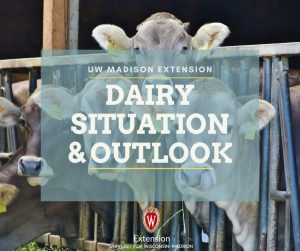Milk prices continue to strengthen since their low in February. The February Class III price was $15.75 and had increased to $17.67 in April with May forecasted to be around $18.90. The February Class IV price was $13.19 and had increased to $15.42 in April with May forecasted to around $16.20. The higher Class III price is the result of cheese prices strengthening the end of April into early May and higher dry whey prices at $0.63 to $0.64 per pound. A year ago, dry whey was $0.39 per pound. The higher dry whey price has added about $1.45 to the Class III price. The higher Class IV price is the result of both higher average butter and nonfat dry milk prices. While butter and nonfat dry milk prices are holding cheese prices have taken a sharp downturn which spells a lower Class III price by June. On the CME the 40-pound cheddar block cheese price has fallen $0.2325 per pound from $1.8125 mid-May to now $1.5800. Cheddar barrels have fallen $0.1525per pound from $1.7800 mid-May to now $1.6275.
The higher cheese prices early May were driven by stronger demand. There were cheese purchases under the Farm to Families Food Box program which expires the end of May. With improvement in the COVID-19 situation some schools have return to in the classroom instruction and restaurants are more fully open which has increased food service sales. As we approach the grilling season the demand for process cheese increases. This partially explains the spread between barrels and blocks that earlier had barrels $0.20 or more per pound lower than blocks to now with barrels at times higher than blocks or slightly below. And cheese exports for the month of March were up some from a year ago as Mexico, the largest market bought 11% more cheese, the highest cheese export volume to Mexico since June 2018.
Dairy exports also were a very positive factor for higher dry whey, butter and nonfat dry milk prices. March exports on a milk solids equivalent basis set a new record in March and were equivalent to 18.6% of milk production. Exports of nonfat dry milk/skim milk powder and dry whey exports both set all-time highs. Compared to March a year ago exports of nonfat dry milk/skim milk powder were up 18.6%, dry whey 26.9% and butterfat 114.9%.
But cheese prices may be under pressure from relatively high cheese production and cheese stocks. Compared to a year ago cheddar cheese production for March was up 7.8% and total cheese production up 4.8%. March 31st American cheese stocks and total cheese stocks were up 7.1% and 6.7% from a year ago respectively. Also, these stock levels were higher than February stocks.
Forecasting milk prices ahead remains cloudy and uncertain. Further opening of restaurants and a move to more in classroom instruction this fall as well as conventions, conferences and attendance at sports events returning to more normal all support stronger milk and dairy product sales. Dairy exports look positive as the world economy improves and major export markets like Mexico and China increase purchases. Currently U.S. prices of butter, nonfat dry milk/skim milk powder and cheese are very competitive with Oceana and Western Europe. But dry whey prices are above world prices. However, milk production needs to slow down to support milk prices. USDA’s latest forecast has 2021 daily milk production up 2.4% from 2020, the result of an average of 82,000 more milk cows and 1.5% more milk per cow. But with considerably higher feed cost the increase in milk production could slow by the second half of the year with increased culling and smaller increases in milk per cow.
USDA’s milk production report for the month of April is not positive for milk prices. March milk production was revised to an increase of 1.9% from a year ago with April’s production 3.3% higher. Milk cow numbers have been increasing since July of last year. Cow numbers increased another 16,000 March to April. April cow numbers were 113,000 higher than a year ago for a 1.2% increase. Milk per cow for April was 2.0% higher than a year ago.
Several states had relatively high increases in April milk production over a year ago: South Dakota 13.4%, Indiana 11.4%, Texas 7.7%, Minnesota 6.9%, Colorado 6.0%, Kansas 5.4%, Wisconsin 4.6%, Michigan 4.5%, California 4.1%, and New York 2.9%. Except for New York which had no increase in cow numbers from a year ago and California with 1,000 fewer cows, all of the other states had added a lot of cows. The increase in cow numbers in these states were: Texas 29,000, Indiana 19,000, South Dakota 18,000, Minnesota and Michigan 15,000, Wisconsin 14,000, Colorado 11,000, and Kansas 6,000.
Current Class III futures are rather optimistic. Class III is in the low $19’s July through October before dropping to the $18’s for November and December. But it will take a combination of lower milk production, strong domestic sales of dairy products and continued strong exports for these prices to materialize. Current butter, cheese and dry whey prices puts the Class III price in the $17’s. USDA’s latest price forecast has the Class III price averaging just $16.85 for the year compared to $18.16 last year.




